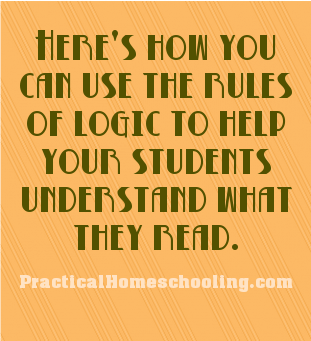Reading Comprehension Part 3: Deductive Reasoning
By Michael Maloney
Printed in Practical Homeschooling #71, 2006.
 How to use the rules of logic to help your student understand what he reads.
How to use the rules of logic to help your student understand what he reads.

|
 |
 In the first two articles of this series on reading comprehension, I wrote about literal comprehension and inferences in comprehension. In literal comprehension, students deal with stated facts. They use the information given to answer questions which can be directly answered by applying the appropriate fact. With inferences, students have to draw a relationship between two or more objects or events with information that is either given or assumed in the material.
In the first two articles of this series on reading comprehension, I wrote about literal comprehension and inferences in comprehension. In literal comprehension, students deal with stated facts. They use the information given to answer questions which can be directly answered by applying the appropriate fact. With inferences, students have to draw a relationship between two or more objects or events with information that is either given or assumed in the material.
In this article I will outline how to use deductive reasoning in order to understand information. Deductive reasoning is what many teachers consider "higher order thinking skills." The student has to use at least two facts, rules, or laws and to draw a valid conclusion based on the information given.
Deductive reasoning is sometimes presented so that it appears to be more complicated than it actually is. The fact that deductions are sometimes called logical syllogisms and taught as part of university philosophy courses in logic allows them to be considered more complex than is necessary to understand them.
Rules about Deductions
Like almost any other thought process, logical deductions become much easier to understand if the student is equipped with certain strategies. First of all, deductions can always be simplified into three distinct parts: the rule, a given fact, and a conclusion. The first part of the deduction, called the rule, is the most critical component. The form in which the rule is given predetermines the conclusion which the student can draw from any fact.
Deduction rules have two critical components. They can be either universal or particular. Universal deduction rules apply to all members of the set or class to which they refer. Particular rules apply to only some of the members or examples of the set.
An example of a universal statement about all members of a class or set would be: All snakes crawl.
An example of a particular statement which applies to only some members of a class or set is: Some snakes are poisonous.
Universal or Particular?
Unless students can differentiate between a universal rule and a particular rule, they are likely to make errors in their conclusions about the information they have read. If the rule is particular, in that it only refers to some of the members of a class, the conclusion of any deduction must always reflect that by saying "maybe" or "perhaps."
A deduction with a universal rule, a fact, and a conclusion would be:
Universal Rule: All snakes crawl.
Fact: An adder is a snake.
Conclusion: So, an adder crawls.
We know that the conclusion is correct because the rule applies to all snakes, including adders.
A deduction with a particular rule, a fact, and a conclusion would be:
Particular Rule: Some snakes are poisonous.
Fact: An adder is a snake.
Conclusion: So, maybe an adder is poisonous.
We cannot conclude that an adder is poisonous on the basis of this information alone, because only some snakes are poisonous and the adder may or may not fall into that group.
Positive or Negative?
The Deduction Rule can also either be positive or negative. Whether it is positive or negative predetermines whether the conclusion is positive or negative.
Deductions with a positive rule are given in examples 1 and 2:
Universal Rule: All snakes crawl
Particular Rule: Some snakes are poisonous.
Deductions with negative rules would be stated like this:
Universal Rule: No constrictors are poisonous.
Particular Rule: Some snakes are not poisonous.
If the rule is a negative statement, the conclusion must also always be a negative statement.
Universal Negative Rule: No constrictors are poisonous.
Fact: A python is a constrictor.
Conclusion: No python is poisonous (or, A python is not poisonous.)
Given the nature of Deduction Rules we can create a simple matrix for dealing with deductions:
| |
Is the Deduction Rule |
| Universal? |
Particular |
| then use: |
| Positive? |
All are |
Maybe some are |
| Negative? |
None is, are |
Maybe most are not |
Once students can determine the nature of the rule of a deduction, the rest is relatively easy. They add the fact as the middle of the deduction (e.g. A python is a snake) and then use the matrix to draw the conclusion.
Universal Positive. All snakes crawl. A python is a snake. So a python crawls (or, So all pythons crawl.)
Particular Positive. Some snakes are poisonous. A python is a snake. So maybe a python is poisonous.
Universal Negative. No constrictors are poisonous. A python is a constrictor. So no pythons are poisonous.
Particular Negative. Some snakes are not poisonous. A python is a snake. So maybe a python is not poisonous.
A Rule About Conclusions
Sometimes the most difficult part of forming the conclusion is in deciding which nouns and or adjectives from the rule and the fact to put in the conclusion.
The student might conclude:
Some snakes are not poisonous. A python is a snake. So a python is not a snake.
To avoid having students chose the incorrect noun to complete the deduction, we can teach them a rule. The noun that is in the rule and in the fact cannot be in the conclusion.
Some snakes are not poisonous. A python is a snake. So maybe a python is not poisonous.
The noun "snake" is in the rule and in the fact, so it cannot appear in the conclusion. The student should choose the remaining noun (python) and adjective (poisonous) to make up a sentence for the conclusion.
Finding Deductions in Passages
In most cases, the information in textbooks will not be stated directly as deductions for the student. The student will have to sift through the material to find statements that could be the rule component of a deduction. Key words such as "all, most, some, no, none" followed by a statement of fact are indicators of a possible deduction. The author might write, "Some people think that all snakes are dangerous." The author may then continue on to describe particular snakes. The student is left to conclude which ones may or may not be dangerous. Being able to analyze the deduction makes coming to the correct conclusion much easier.
In order to help make students more familiar with deductive reasoning, the following strategy is suggested.
Strategy
- Make up some rule statements
- Use both positive and negative rule statements
- Use both universal and particular rule statements.
- Add a fact statement.
- Use the same fact statement with different types of rule statements.
- Ask the student to make the conclusion statement.
Application
- Look through your student's textbooks for rule statements.
- Find the fact statements that follow.
- See if the author draws a conclusion using the rule and the fact statement.
- See if the student can analyze the deduction using the matrix to determine if it is valid.
Conclusion
Teaching deductive reasoning is a lot like teaching other skills. If you can show the student a pattern or system that works reliably, the learning becomes more systematic and easier for both teacher and learner. Teaching deductive thinking means teaching the students how to find the rule and the fact that make up a deduction. Then the student can see if the conclusion follows the pattern and is valid or if it breaks the pattern and is invalid.